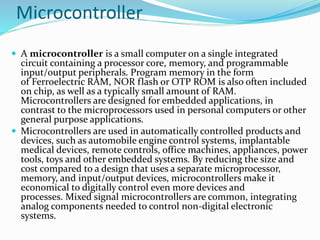Psa(group 3)
- 2. NAME ID 1. Alam iftekhar ul 12-22225-3 2. Hasan,Md.Nazmul Anas Bin 13-24437-2 3. Shiblu Nazmul Huda 12-22183-3 4.Rahman,MD.Sadiqur 13-24415-2
- 3. Presentation Topic Auto Water Pump Switch Using Microcontroller(Ardunio)
- 4. Why we choose this topicâĶâĶâĶ ï Water supply is irregular because pumps are not being operated in proper time. ï Water is being wasted because pumps are not switched off immediately after the water tank is full. ï Pumps are often burning out due to high voltage in-rush current. ï Pumps are running while the reservoir is empty, which is shortening the lifetime of the pumps ï Continuous load-shedding is making you worried about continuous supply of water.
- 5. OverviewâĶâĶâĶâĶ When Water Tank Level goes down, pump turns ON automatically. When Water Tank gets full, pump turns OFF automatically. Ensures regular supply of water. Prevents waste of water. To reduce the electricity loss.
- 6. Microcontroller ï A microcontroller is a small computer on a single integrated circuit containing a processor core, memory, and programmable input/output peripherals. Program memory in the form of Ferroelectric RAM, NOR flash or OTP ROM is also often included on chip, as well as a typically small amount of RAM. Microcontrollers are designed for embedded applications, in contrast to the microprocessors used in personal computers or other general purpose applications. ï Microcontrollers are used in automatically controlled products and devices, such as automobile engine control systems, implantable medical devices, remote controls, office machines, appliances, power tools, toys and other embedded systems. By reducing the size and cost compared to a design that uses a separate microprocessor, memory, and input/output devices, microcontrollers make it economical to digitally control even more devices and processes. Mixed signal microcontrollers are common, integrating analog components needed to control non-digital electronic systems.
- 7. Arduino ï Arduino is an open-source computer hardware and software company, project and user community that designs and manufactures microcontroller-based kits for building digital devices and interactive objects that can sense and control the physical world. ï The project is based on a family of microcontroller board designs manufactured primarily by Smart Projects in Italy, and also by several other vendors, using various 8-bit Atmel AVR microcontrollers or 32-bit Atmel ARM processors. These systems provide sets of digital and analog I/O pins that can be interfaced to various expansion boards ("shields") and other circuits. The boards feature serial communications interfaces, including USB on some models, for loading programs from personal computers. For programming the microcontrollers, the Arduino platform provides an integrated development environment (IDE) based on the Processing project, which includes support for C, C++ and Java programming languages.
- 11. Codes
- 12. A is connected to K and B after inverting connected to J
- 13. For the lower sensor(J) the output is inverted before giving it to the flip-flop So when there is water on both sensors, input = 0 1, output = 0 = motor off when water is coming down after filling up, input = 0 0, output = 0 = motor off when water comes below the lower sensor, input = 1 0, output = 1 = motor on when water starts rising from the lower sensor, input = 0 0, output = 1 = motor on when there is water on both sensors, input = 0 1, output = 0 = motor off
- 14. . ï Timing diagram âĶâĶâĶâĶâĶâĶâĶâĶ 0 0 1 0 0 J 0 1 1 1 0 K 0 1 0 1 0 1 Clk 1 1 0 0 1 Q
- 15. Working of circuit 2 ï The analog input A0 to A4 is used to sense the water level. ï A 16 X 2 display is connected which shows different water level output and motor status ï A buzzer is connected to dig pin7 which sends signal to buzzer when circuit have problem ï Digital pin8 controls the relay
- 16. Conclusion âĶâĶâĶâĶâĶâĶâĶâĶâĶâĶâĶ ** The aim of the design of an automatic pump switch was to manage electricity and water resources efficiently. **The system worked according to specification and proved quite satisfactory. ** Finally, it reduces stress associated with manual water pump controller, which require that somebody go to physically switch them on and off.
- 17. References 1. http://auto.howstuffworks.com/under-the- hood/car-part-longevity/water-pump-last.htm 2. http://auto.howstuffworks.com/cooling- system4.htm 3. "Programming Arduino Getting Started with Sketches". McGraw-Hill. Nov 8, 2011. Retrieved 2013- 03-28.



















